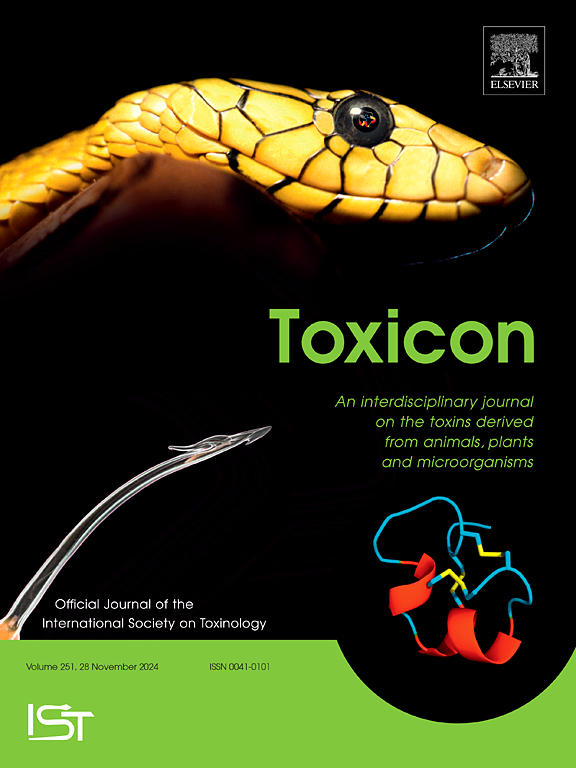Ezetimibe protects against alpha-amanitin-induced hepatotoxicity by targeting the NTCP receptor: Mechanistic insights from in vitro and in vivo models
IF 2.6
4区 医学
Q2 PHARMACOLOGY & PHARMACY
引用次数: 0
Abstract
Background
α-Amanitin, the primary lethal toxin of Amanita phalloides, induces irreversible hepatotoxicity by selectively inhibiting RNA polymerase II, leading to transcriptional arrest. Despite advancements in managing mushroom poisoning, a targeted antidote remains unavailable. The sodium taurocholate co-transporting polypeptide (NTCP), a hepatic bile acid transporter, facilitates α-amanitin entry into hepatocytes. Pharmacological blockade of NTCP represents a promising therapeutic strategy.
Objective
To evaluate ezetimibe, an NTCP inhibitor, as a protective agent against α-amanitin-induced hepatotoxicity.
Methods
Transcriptomic profiling of α-amanitin-exposed mouse liver tissues (NCBI accession: PRJNA809431) was conducted using DESeq2. Molecular docking simulations assessed interactions between NTCP, α-amanitin, and ezetimibe. Therapeutic efficacy was evaluated in vivo (mouse models) and in vitro (cultured hepatocytes). Key outcomes included survival rates, liver injury markers (ALT, AST), apoptosis (Bax/Bcl-2 ratio), and oxidative stress parameters.
Results
NTCP expression was upregulated in α-amanitin-exposed livers. Molecular docking revealed α-amanitin binding at NTCP residue VAL-160, whereas ezetimibe interacted with LEU-14 and ASN-17. Ezetimibe (50 mg/kg) improved survival rates from 25 % to 80 % in α-amanitin-exposed mouse models (p < 0.01), reduced serum ALT (68 ± 5 U/L vs. 165 ± 12 U/L; p < 0.05) and AST (72 ± 6 U/L vs. 158 ± 10 U/L; p < 0.05), and attenuated apoptosis (60 % decrease in Bax/Bcl-2; p < 0.05). In vitro, ezetimibe restored hepatocyte viability 2.1-fold (p < 0.05) and reduced oxidative stress (40 % decrease in malondialdehyde; p < 0.05). Transcriptomic analysis linked α-amanitin toxicity to p53-mediated apoptosis.
Conclusion
Ezetimibe protects against α-amanitin hepatotoxicity by blocking NTCP-mediated uptake, supporting its potential clinical repurposing as a targeted antidote.
依折替米贝通过靶向NTCP受体来保护α - amantin诱导的肝毒性:来自体外和体内模型的机制见解
背景:α-Amanitin是灰伞伞(Amanita phalloides)的主要致死毒素,可通过选择性抑制RNA聚合酶II诱导不可逆肝毒性,导致转录阻滞。尽管在处理蘑菇中毒方面取得了进展,但仍然没有针对性的解毒剂。牛磺胆酸钠共转运多肽(NTCP)是一种肝胆汁酸转运体,促进α-amanitin进入肝细胞。药物阻断NTCP是一种很有前途的治疗策略。目的:评价NTCP抑制剂依折替米对α-阿曼霉素肝毒性的保护作用。方法:采用DESeq2对α-amanitin暴露小鼠肝组织(NCBI accession: PRJNA809431)进行转录组学分析。分子对接模拟评估了NTCP、α-amanitin和ezetimibe之间的相互作用。在体内(小鼠模型)和体外(培养肝细胞)评估治疗效果。主要结局包括生存率、肝损伤标志物(ALT、AST)、细胞凋亡(Bax/Bcl-2比值)和氧化应激参数。结果:NTCP在α-amanitin暴露的肝脏中表达上调。分子对接发现α-amanitin与NTCP残基VAL-160结合,而依折替米则与LEU-14和ASN-17相互作用。依折替贝(50 mg/kg)可使α- amamitin暴露小鼠模型的存活率从25%提高到80% (p < 0.01),降低血清ALT(68±5 U/L vs. 165±12 U/L);p < 0.05)和AST(72±6 U/L∶158±10 U/L);p < 0.05),细胞凋亡减弱(Bax/Bcl-2降低60%;P < 0.05)。依折替米比在体外使肝细胞活力恢复2.1倍(p < 0.05),并降低氧化应激(丙二醛降低40%;P < 0.05)。转录组学分析将α-amanitin毒性与p53介导的细胞凋亡联系起来。结论:依zetimibe通过阻断ncp介导的摄取来预防α-amanitin肝毒性,支持其作为靶向解毒剂的潜在临床用途。
本文章由计算机程序翻译,如有差异,请以英文原文为准。
求助全文
约1分钟内获得全文
求助全文
来源期刊

Toxicon
医学-毒理学
CiteScore
4.80
自引率
10.70%
发文量
358
审稿时长
68 days
期刊介绍:
Toxicon has an open access mirror Toxicon: X, sharing the same aims and scope, editorial team, submission system and rigorous peer review. An introductory offer Toxicon: X - full waiver of the Open Access fee.
Toxicon''s "aims and scope" are to publish:
-articles containing the results of original research on problems related to toxins derived from animals, plants and microorganisms
-papers on novel findings related to the chemical, pharmacological, toxicological, and immunological properties of natural toxins
-molecular biological studies of toxins and other genes from poisonous and venomous organisms that advance understanding of the role or function of toxins
-clinical observations on poisoning and envenoming where a new therapeutic principle has been proposed or a decidedly superior clinical result has been obtained.
-material on the use of toxins as tools in studying biological processes and material on subjects related to venom and antivenom problems.
-articles on the translational application of toxins, for example as drugs and insecticides
-epidemiological studies on envenoming or poisoning, so long as they highlight a previously unrecognised medical problem or provide insight into the prevention or medical treatment of envenoming or poisoning. Retrospective surveys of hospital records, especially those lacking species identification, will not be considered for publication. Properly designed prospective community-based surveys are strongly encouraged.
-articles describing well-known activities of venoms, such as antibacterial, anticancer, and analgesic activities of arachnid venoms, without any attempt to define the mechanism of action or purify the active component, will not be considered for publication in Toxicon.
-review articles on problems related to toxinology.
To encourage the exchange of ideas, sections of the journal may be devoted to Short Communications, Letters to the Editor and activities of the affiliated societies.
 求助内容:
求助内容: 应助结果提醒方式:
应助结果提醒方式:


